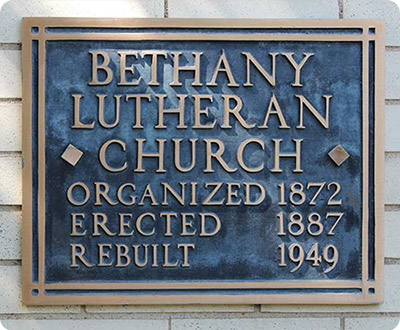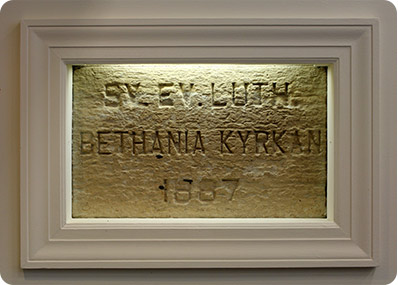Our History
Worshiping and serving God in Batavia since 1872.
 The Swedish immigrants who settled in Batavia in the middle of the 19th Century came mainly from a few neighboring parishes in Halland, Sweden. Until 1872 the Swedish Lutherans went to Geneva to worship, where a Swedish Lutheran Church had been organized in 1853.
The Swedish immigrants who settled in Batavia in the middle of the 19th Century came mainly from a few neighboring parishes in Halland, Sweden. Until 1872 the Swedish Lutherans went to Geneva to worship, where a Swedish Lutheran Church had been organized in 1853.
In March of 1872 a group met on the second floor of the August Anderson home at 15 South Jefferson Street and formed a Swedish Lutheran Church, which consisted of 53 people including 36 adults, 14 young men and three young women. In little more than six months the church was organized, property purchased, and church building prepared for worship. Part of the property on which the present church is located was for sale and an old school building stood on the property. On March 26, 1872, the contract to purchase the property was signed and alterations to make the school building suitable for use as a church were started.
The permanent church organization, “The Swedish Evangelical Lutheran Bethany Church of Batavia, Illinois” was effected on August 1, 1872, the remodeled church was dedicated on September 1, 1872, and the church was received into the Augustana Synod on September 26, 1872.
The Reverend C. O. Lindell from Geneva came occasionally weekdays to preach, but in a few months the Batavians joined with Grace Lutheran Church in Aurora church and called a pastor for the two churches. The arrangement continued until 1893, and a number of pastors served the two churches from 1872 to 1893.
Swedish was the original language of the church. Children attended summer Swede school to learn Catechism and Bible History in Swedish. This summer school and confirmation in Swedish continued until after World War I. In 1919, an interesting method of religious instruction, the “Batavia Plan,” was introduced in Batavia churches. Grade school children were excused from public school for a part of the day each Thursday and to attend their church for religious instruction. This plan was found to be legal, and the dismissed-time Thursday School continued until 1985.
Church services in Swedish continued for many years until eventually a Swedish service and an English service were held each Sunday. The Swedish service continued until after World War II, and now the only remaining vestige of the Swedish language in the church is the Christmas morning Julotta service.
 The small remodeled schoolhouse served the church until 1887, when it was torn down and a red brick church with a tall steeple was erected. Additional improvements were made and the church bell was added in 1904. In 1948-49 the church was rebuilt: The steeple was torn down, an educational unit was added, tower and entrance rebuilt, and the church re-bricked.
The small remodeled schoolhouse served the church until 1887, when it was torn down and a red brick church with a tall steeple was erected. Additional improvements were made and the church bell was added in 1904. In 1948-49 the church was rebuilt: The steeple was torn down, an educational unit was added, tower and entrance rebuilt, and the church re-bricked.
The latest addition to the church, the educational/office/fellowship wing, was made possible by the purchase of land on First Street which was traded to the School District for a parcel adjoining Bethany to the south. The addition was constructed in 1980. In 1997 the church was renovated and the sanctuary redecorated, including new and improved lighting and sound systems as well as air conditioning. The tower had also undergone rebricking and remodeling to guard against future damage.
By the end of 1872, the church’s first year, there were 60 confirmed members in Bethany. By 1905 this number had reached 433, in addition to which there were 411 children. The confirmed membership continued to grow, reaching 923 in 1966 and 1207 at the end of 1995.
Though the local church building, staff, and programs have required considerable funds, giving for benevolences and needs other than the local church have also increased. Giving for the many needs and programs of the church at large is through the Metropolitan Chicago Synod of the Evangelical Lutheran Church in America. Beginning in 1951 Bethany sponsored Dr. Kenneth and Eloise Dale as missionaries to Japan (now recently retired), first by direct contributions and later through the Synod. A Scholarship fund, funded mainly by gifts from members, friends, and former recipients, is available to aid seminary and college students attending Lutheran schools. The history of Bethany is filled with instances of Bethany aiding various needs and causes, local and otherwise, from the Batavia Food Pantry to new congregations in Illinois to World Hunger programs.
During its 141 year existence hundreds of people have contributed in numerous ways to the operation, growth, education, and success of Bethany, as well as leadership in the spiritual welfare of all. Reverend Philip G. Thelander was pastor of Bethany for 25 years and Reverend Gustav Lund served for 22 years. Probably the longest service to the church was by Gerda “Jennie” Peterson who was church organist for 55 years. Having played for the Sunday School before her confirmation and for the Ladies Aid after retirement as organist, Jennie served the church a total of 79 years. Miss Bernice Olson was secretary of the church from 1949 to 1980, a total of 31 years, in addition to which she served in innumerable volunteer activities before 1949, during her term as secretary, and to the present. Warren Felts served as choir director from 1942 to 1976 and many sang in the choir from 25 to over 50 years, with the Freedlund family serving a combined total of over 200 years in the choir.
Bethany was organized by Swedish immigrants as a Swedish church and was a member of the Augustana Lutheran Church (churches of Swedish heritage) until 1962. In 1962 the Augustana Lutheran Church joined with other Lutheran churches to form the Lutheran Church in America (LCA). In 1988 the LCA united with The American Lutheran Church (ALC) and the Association of Evangelical Lutheran Churches to form the Evangelical Lutheran Church in America (ELCA).

